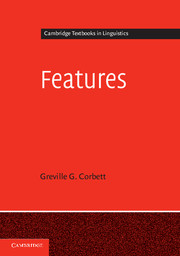Book contents
- Frontmatter
- Contents
- Figures
- Tables
- Preface
- Abbreviations
- 1 Why features?
- 2 Formal perspectives
- 3 Features for different components
- 4 Justifying particular features and their values
- 5 Typology
- 6 Canonical Typology and features
- 7 Determining feature values
- 8 Feature-value mismatches
- 9 Conclusions
- Appendix Standards and implementations
- References
- Author index
- Language index
- Subject index
Appendix Standards and implementations
Published online by Cambridge University Press: 05 November 2012
- Frontmatter
- Contents
- Figures
- Tables
- Preface
- Abbreviations
- 1 Why features?
- 2 Formal perspectives
- 3 Features for different components
- 4 Justifying particular features and their values
- 5 Typology
- 6 Canonical Typology and features
- 7 Determining feature values
- 8 Feature-value mismatches
- 9 Conclusions
- Appendix Standards and implementations
- References
- Author index
- Language index
- Subject index
Summary
Since features are shared across sub-areas of the discipline, from the highly theoretical to the most applied, there are practical steps which can have general benefit. Thus there are various proposals for standardizing and generalizing the use of features and values. It is important that such initiatives should be fully informed by the linguistic issues. We shall also look at instances of using features in large-scale implementations; these serve as a valuable testing-ground for theories of features and can come to operate as de facto standards.
The Leipzig Glossing Rules
The Leipzig Glossing Rules were introduced in §1.3, with source information, and they are used through the book. Although features are common currency, they can lead to confusion even at the most basic level, through the use of abbreviations in glossing which have different interpretation. The Leipzig Glossing Rules represent a bottom-up approach to standardization and are a useful step forward. They give conventions for glossing, and propose some standard abbreviations. At the simplest level it is eminently sensible that we should use the same symbols (e.g. ‘=’ for clitic boundary) and the same abbreviations. We should be certain whether a colleague wishes to indicate perfect tense (prf) or perfective aspect (pfv). That is, we should disagree on real issues, not be sidetracked by gratuitous differences in labelling. This is a bare minimum for the discipline. Interestingly, at the annual meeting of the Societas Linguistica Europaea (2011) it was specified that the Leipzig Glossing Rules should be used in handouts, which is one sign of progress being made.
- Type
- Chapter
- Information
- Features , pp. 265 - 268Publisher: Cambridge University PressPrint publication year: 2012



